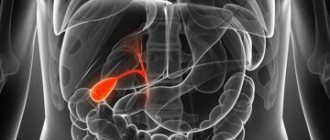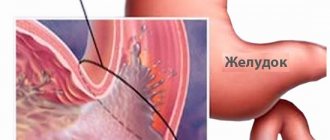As life expectancy increases, so does the number of older people. It is no secret that older people often suffer from several chronic diseases at once. As the body ages, it undergoes physical and physiological changes, as do the body's nutritional needs.
What effect does aging have on the gastrointestinal tract? What gastrointestinal diseases increase the risk in old age? How to promptly identify and correctly treat functional gastrointestinal disorders?
How is functional dyspepsia diagnosed? What makes diagnosis difficult for older patients?
How is functional dyspepsia diagnosed?
Functional dyspepsia is persistent or recurring pain or discomfort in the upper abdomen (epigastric region) in the absence of organic pathology that may explain the symptoms of dyspepsia. Discomfort includes symptoms such as a feeling of false satiety, bloating, sometimes nausea, and belching.
Functional dyspepsia is diagnosed according to European criteria if one or more of the following symptoms persist for at least 3 months (at least 6 months after the onset of symptoms):
- unpleasant feeling of fullness after eating;
- early feeling of fullness;
- pain in the upper middle abdomen;
- burning sensation in the epigastrium;
- there is no organic pathology that could justify the symptoms of dyspepsia.
When symptoms of functional dyspepsia appear, it is recommended to begin treating the patient with GERD even before diagnosis. In case of danger, the patient is immediately sent for an endoscopic examination. It is advisable to test for Helicobacter pylori infection.
Additional testing includes testing for occult gastrointestinal bleeding, colonoscopy, electrocardiogram, and other tests needed to rule out an organic cause for symptoms.
In geriatric patients, diagnosis is complicated by the many symptoms of functional dyspepsia, intertwined with other functional disorders of the gastrointestinal tract. The gastroenterologist must remain vigilant because organic dyspepsia may present with similar symptoms.
Functional dyspepsia is not a life-threatening disease, but it affects the patient’s quality of life: attacks of phobia, anxiety and panic of organic diseases occur, patients sometimes conduct unnecessary complex studies without consulting a specialist.
What symptoms can be dangerous?
So-called red flag symptoms indicate organic pathology. This:
- age over 55 years;
- weight loss;
- progressive swallowing disorder;
- persistent vomiting;
- signs of gastrointestinal bleeding (vomiting with blood or so-called coffee grounds, black stools);
- family history of cancer.
Additional symptoms include treatment failure, need for nonsteroidal anti-inflammatory drugs (NSAIDs) and aspirin, ferrodeficiency anemia, cough and nocturnal shortness of breath, changes in bowel movements, abdominal bloating, lymphadenopathy, and chest pain.
What causes functional dyspepsia?
Symptoms of functional dyspepsia are usually caused by increased visceral sensitivity, in which normal bowel movements cause a feeling of pain. Gastrointestinal dysmotility is associated with a variety of symptoms, from swallowing problems to urinary incontinence.
There is a proven connection between the brain and the gastrointestinal tract - anxiety or depression cause gastrointestinal diseases. Genetic factors, such as abnormalities of the serotonin transport gene, are also important.
Changes in the bacterial flora of the intestines cause bloating, pain and loss of bowel movements. Causes include lifestyle factors such as overeating, irregular eating habits, smoking and alcohol.
In geriatric patients, functional dyspepsia can be caused by additional factors, such as decreased production of enzymes in saliva, gastric juice, bile and pancreas, problems with chewing (missing teeth, caries, periodontal pathology, dentures), sedentary lifestyle (impaired bowel function) , nutrition, taking medications.
Foods that may cause symptoms of dyspepsia include lactose, caffeine, eggs, some grains, yeast products, fatty foods, and alcohol. Medicines include antibiotics, bisphosphonates, corticosteroids, herbal medications, iron supplements, metformin, aspirin, NSAIDs, opiates, potassium chloride, theophylline.
TOP 7 simple tips will help
Not tea, coffee, mineral water or juices, but pure still water. The less you drink pure water, the slower your gastrointestinal tract works. It is water that helps the digestive system and the entire body work stably and promptly remove accumulated toxins, which often become the cause of ailments and diseases.
Drink more water.- Love an active lifestyle. You don't have to go to the gym right away, start with walking in the fresh air. They can be short, but must be regular. Physical activity stimulates the functioning of all organs of the body, including the gastrointestinal tract. Start walking and you will forget about bloating, constipation and other unpleasant problems.
- Avoid fast food. There is an ideal diet for losing weight or cleansing the body. You need to exclude sweets, fatty foods and starchy foods - and the body itself will begin to recover and get rid of ballast in the form of excess fat. Instead of fatty foods, sweets and baked goods, eat vegetables and fruits, steamed lean meat.
- Include fiber in your diet. Foods high in fiber regulate intestinal function and ensure uniform absorption of glucose into the blood, as well as speed up metabolism and help lose weight and cleanse the body of toxins. Not a day without whole grain cereals, vegetables and fruits!
- Eat little and often. Yes, you have a lot of work. Yes, you are used to eating in the evening. But it is better to rebuild the body to the correct daily routine, otherwise in a few years you will have to spend money not on vacation, but on treatment. Why such sacrifices if you can literally change your daily routine in 1-2 months and see the first positive results?
- Watch what you eat carefully. If you have a very sensitive digestive system, do not provoke gas or constipation by evening overeating, carbonated drinks, sweets, salty or spicy foods. Try to control yourself - and then your stomach will work stably.
- Take remedies to improve digestion. Following a diet in combination with medications that contain special digestive enzymes will help improve stomach function even in the presence of certain diseases. The main thing is to consult with your doctor. You should not self-medicate - this can aggravate the situation.
As you can see, these recommendations are not that difficult to implement. You just need to set a goal. And your goal is very important - to help the digestive system work without failures for many years. You can read more about why indigestion occurs in our article.
What is the connection between functional dyspepsia and the functioning of the pancreas?
What Causes Functional Dyspepsia
Functional digestion is impaired when the pancreas cannot produce enough enzymes and other active substances needed to break down food to meet physiological needs. Exocrine pancreatic insufficiency causes dyspepsia in 19–35%. cases.
With functional dyspepsia, one third of patients have a deficiency of pancreatic enzymes. About 50% of patients with gallstones after gallbladder surgery complain of dyspepsia.
A relative deficiency of pancreatic enzymes in elderly patients may be a consequence of incomplete chewing (due to lack of teeth), constant changes in the pancreas. 11.5% of people over 50 years of age are diagnosed with exocrine pancreatic dysfunction, the percentage of which is increasing every decade. Enzymes may be deficient due to constant changes in the stomach lining,
Description of the pathology
The term “lazy stomach syndrome” is rarely used in practical medicine. The complex of symptoms characteristic of this condition is referred to as “functional dyspeptic disorder” or functional dyspepsia. The disease code according to ICD-10 is K30, classified as a functional disorder of the stomach. Lazy stomach syndrome differs from organic dyspepsia in the absence of any organic (directly related to the functioning of the organ) pathologies and clinically significant changes in the mucosa. The syndrome has predominantly symptomatic manifestations, with no structural or morphological damage to the epithelial lining of the stomach. The initial examination fails to identify the cause of digestive dysfunction.
The pathogenetic mechanism for the development of lazy stomach pathology is presented by three main dysfunctions in the table below.
How is it recommended to treat elderly patients with functional dyspepsia today?
Treatment of functional dyspepsia is selected individually. It has 2 goals—relieving symptoms and educating the patient to understand the functional nature of the disorder in order to prevent relapse.
Treatment tactics are chosen depending on the symptoms, for example:
- for heartburn and pain, H 2 RA (ranitidine) or proton pump inhibitors (PPIs) are prescribed;
- for bloating - simethicone;
- for indigestion - pancreatic enzymes.
The effectiveness of treatment varies. Helicobacter pylori eradication - 6-14%, PSI - 7-10%, H 2 RA (ranitidine) - 8-35%, prokinetics - 18-45%. H 2 RA (ranitidine) reduces the symptoms of dyspepsia by reducing microscopic inflammation of the stomach or duodenum. But combination therapy always gives the best effect.
Also important conditions are adherence to a diet selected by a gastroenterologist and improvement of chewing function through, for example, dental prosthetics or control over chewing food. Elderly patients are not recommended to eat while watching TV, reading, or in other distracting environments. Unfortunately, with age-related disorders, more and more attention needs to be paid to the nutrition process, and what was possible in youth is no longer categorically allowed for older patients.
Lazy stomach in children
Almost a third of patients diagnosed with lazy stomach syndrome are children from age groups particularly vulnerable to this pathology. Since one of the catalysts for digestive dysfunction, regardless of the patient’s age, is stress, these groups include children, whose risk of emotional upheaval is greatest compared to other age categories.
The periods of maximum risk for the development of CVD among children and adolescents are shown in the table.
In infants, lazy stomach syndrome is not diagnosed so often and is usually associated with concomitant diseases and disorders of the digestive system.
Important!
During these periods, it is especially important for parents to pay enough attention to organizing children's nutrition and routine. You should not overload your child with developmental activities (if the child is going to first grade, it is better to postpone them for a year). It is important to limit the time you watch TV, the duration of active games 2 hours before bedtime, and the use of electronic devices (tablets, computers, phones) during the day.
Diet for age-related functional dyspepsia - why go to a gastroenterologist
Diet for age-related functional dyspepsia
As for diet, each gastrointestinal disease has its own conditions, therefore, when choosing the regimen, type and composition of nutrition, you cannot use guidelines from the Internet. The choice of food depends on the type and severity of gastrointestinal dysfunction, the affected organ, and even the acidity in the stomach.
The exact diet is prescribed by a gastroenterologist only after examination. Everything that is recommended by a doctor before making a diagnosis is purely a general recommendation.
Standard set of rules:
- do not eat fatty, fried, smoked, canned foods;
- increase the amount of liquid to 2 liters. per day;
- limit the amount of salt and spices.
In fact, the patient may be completely prohibited from eating salt, acidic foods, or mineral water with a certain composition. Some patients should not drink freshly squeezed juices or eat foods containing lactose or, for example, legumes. Other patients may be advised to eat low-fat meats, restrict calories, etc., while underweight patients should not restrict calories.
Also, every patient should be tested for diabetes mellitus and pre-diabetic conditions, as they are closely related to age and often go hand in hand with functional dyspepsia. It is enough to do a simple test - take a blood test and do an ultrasound of the pancreas to understand what is happening to this organ and whether the patient is at risk of diabetes. If a violation is detected, the gastroenterologist must adjust the diet taking into account disturbances in glucose metabolism.
It is important to understand that when dyspepsia and diabetes mellitus are combined, diets that involve temporary and especially prolonged fasting are prohibited. This can result in a state of hypoglycemia and even coma.
Elderly patients need to be careful with vegetarian diets, since with age the body needs calcium, iron and other elements that plant foods may not contain.
Fully or partially limited products
The diet for stomach diseases with normal/high acidity should exclude/limit:
- Fast food products/semi-finished products.
- Soups with fried dressing, first courses with the addition of onions, legumes, onion soup, kidneys, cabbage, millet. All soups are made with meat/fish/mushroom broths.
- Stringy/fatty/salted and fried meat, fish, smoked meats, fried potatoes, lard, pancakes, goose, duck, pancakes, fried donuts, canned fish.
- Meat, mushroom, fish, onion, garlic, mayonnaise-based sauces.
- Bean dishes, millet, wheat, corn, pearl barley, barley porridge. Difficult-to-digest foods (mushrooms), vegetables with coarse fiber (radishes), irritating coolants (ginger, garlic, green onions, pickled vegetables), hot spices/seasonings.
- Ice cream, chocolate, nut and raisin casseroles, sweet nut buns.
- Some fruits (grapes, figs, pears, lingonberries, raspberries, blueberries).
- Fatty fermented milk drinks, sour cottage cheese, fatty cheese.
Table of prohibited products
| Proteins, g | Fats, g | Carbohydrates, g | Calories, kcal | |
Vegetables and greens | ||||
| vegetables legumes | 9,1 | 1,6 | 27,0 | 168 |
| swede | 1,2 | 0,1 | 7,7 | 37 |
| cabbage | 1,8 | 0,1 | 4,7 | 27 |
| sauerkraut | 1,8 | 0,1 | 4,4 | 19 |
| green onion | 1,3 | 0,0 | 4,6 | 19 |
| bulb onions | 1,4 | 0,0 | 10,4 | 41 |
| cucumbers | 0,8 | 0,1 | 2,8 | 15 |
| canned cucumbers | 2,8 | 0,0 | 1,3 | 16 |
| parsnip | 1,4 | 0,5 | 9,2 | 47 |
| parsley (root) | 1,5 | 0,6 | 10,1 | 49 |
| radish | 1,2 | 0,1 | 3,4 | 19 |
| white radish | 1,4 | 0,0 | 4,1 | 21 |
| turnip | 1,5 | 0,1 | 6,2 | 30 |
| celery | 0,9 | 0,1 | 2,1 | 12 |
| canned tomatoes | 1,1 | 0,1 | 3,5 | 20 |
| green beans | 2,8 | 0,4 | 8,4 | 47 |
| horseradish | 3,2 | 0,4 | 10,5 | 56 |
| garlic | 6,5 | 0,5 | 29,9 | 143 |
| spinach | 2,9 | 0,3 | 2,0 | 22 |
| sorrel | 1,5 | 0,3 | 2,9 | 19 |
Fruits | ||||
| bananas | 1,5 | 0,2 | 21,8 | 95 |
| melon | 0,6 | 0,3 | 7,4 | 33 |
Berries | ||||
| grape | 0,6 | 0,2 | 16,8 | 65 |
Mushrooms | ||||
| mushrooms | 3,5 | 2,0 | 2,5 | 30 |
Cereals and porridges | ||||
| corn grits | 8,3 | 1,2 | 75,0 | 337 |
| pearl barley | 9,3 | 1,1 | 73,7 | 320 |
| Wheat groats | 11,5 | 1,3 | 62,0 | 316 |
| millet cereal | 11,5 | 3,3 | 69,3 | 348 |
| barley grits | 10,4 | 1,3 | 66,3 | 324 |
Bakery products | ||||
| vysivkovy bread | 9,0 | 2,2 | 36,0 | 217 |
| Old Russian grain bread | 9,6 | 2,7 | 47,1 | 252 |
| Rye bread | 6,6 | 1,2 | 34,2 | 165 |
Confectionery | ||||
| candies | 4,3 | 19,8 | 67,5 | 453 |
| pastry cream | 0,2 | 26,0 | 16,5 | 300 |
| cookie | 7,5 | 11,8 | 74,9 | 417 |
| butter cookies | 10,4 | 5,2 | 76,8 | 458 |
Ice cream | ||||
| ice cream | 3,7 | 6,9 | 22,1 | 189 |
Cakes | ||||
| cake | 4,4 | 23,4 | 45,2 | 407 |
Chocolate | ||||
| chocolate | 5,4 | 35,3 | 56,5 | 544 |
Raw materials and seasonings | ||||
| seasonings | 7,0 | 1,9 | 26,0 | 149 |
| mustard | 5,7 | 6,4 | 22,0 | 162 |
| ginger | 1,8 | 0,8 | 15,8 | 80 |
| ketchup | 1,8 | 1,0 | 22,2 | 93 |
| mayonnaise | 2,4 | 67,0 | 3,9 | 627 |
| ground black pepper | 10,4 | 3,3 | 38,7 | 251 |
| chilli | 2,0 | 0,2 | 9,5 | 40 |
Meat products | ||||
| pork | 16,0 | 21,6 | 0,0 | 259 |
| salo | 2,4 | 89,0 | 0,0 | 797 |
Sausages | ||||
| dry-cured sausage | 24,1 | 38,3 | 1,0 | 455 |
| sausages | 12,3 | 25,3 | 0,0 | 277 |
Bird | ||||
| duck | 16,5 | 61,2 | 0,0 | 346 |
| goose | 16,1 | 33,3 | 0,0 | 364 |
Fish and seafood | ||||
| dried fish | 17,5 | 4,6 | 0,0 | 139 |
| smoked fish | 26,8 | 9,9 | 0,0 | 196 |
| canned fish | 17,5 | 2,0 | 0,0 | 88 |
Oils and fats | ||||
| animal fat | 0,0 | 99,7 | 0,0 | 897 |
| cooking fat | 0,0 | 99,7 | 0,0 | 897 |
Alcoholic drinks | ||||
| white dessert wine 16% | 0,5 | 0,0 | 16,0 | 153 |
| vodka | 0,0 | 0,0 | 0,1 | 235 |
| cognac | 0,0 | 0,0 | 0,1 | 239 |
| beer | 0,3 | 0,0 | 4,6 | 42 |
Non-alcoholic drinks | ||||
| bread kvass | 0,2 | 0,0 | 5,2 | 27 |
| cola | 0,0 | 0,0 | 10,4 | 42 |
| sprite | 0,1 | 0,0 | 7,0 | 29 |
| tonic | 0,0 | 0,0 | 8,3 | 34 |
| energy drink | 0,0 | 0,0 | 11,3 | 45 |
Juices and compotes | ||||
| Orange juice | 0,9 | 0,2 | 8,1 | 36 |
| grape juice | 0,3 | 0,0 | 14,0 | 54 |
| Cherry juice | 0,7 | 0,0 | 10,2 | 47 |
| Strawberry juice | 0,6 | 0,4 | 7,0 | 31 |
| tangerine juice | 0,8 | 0,3 | 8,1 | 36 |
| tomato juice | 1,1 | 0,2 | 3,8 | 21 |
| * data is per 100 g of product | ||||
What is the treatment method with pancreatic enzymes?
You should start with the lowest effective dose that controls symptoms. The dose can be increased 2-3 times. It is most rational to prescribe enzyme preparations with polymer protective coatings. Such drugs (for example, Mezim) are resistant to gastric juice and correspond to the physiology of the gastrointestinal tract - active enzymes slowly dissolve in the duodenum. Coatings improve the pharmacokinetic and pharmacodynamic properties of enzyme preparations.
The enzymes are more effective when used in combination with antisecretory therapy such as ranitidine. Treatment is effective if abdominal pain, bloating and other symptoms disappear. If the symptoms do not disappear, the doctor should recheck the diagnosis and prescribe other medications.









![Rice. 1. Biopsychosocial model of the genesis of functional gastrointestinal diseases [1].](https://zakam.ru/wp-content/uploads/ris-1-biopsihosocialnaya-model-geneza-funkcionalnyh-zabolevanij-zhkt-1-330x140.jpg)